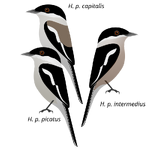| Treecreepers | |
|---|---|
| File:Certhia-americana-001.jpg | |
| Brown Creeper (Certhia americana) | |
| Scientific classification | |
| Kingdom: | Animalia |
| Phylum: | Chordata |
| Class: | Aves |
| Order: | Passeriformes |
| Suborder: | Passeri |
| Superfamily: | Certhioidea |
| Family: | Certhiidae Leach, 1820 |
| genera | |
|
Certhia | |
The treecreepers are a family, Certhiidae, of small passerine birds, widespread in wooded regions of the Northern Hemisphere and sub-Saharan Africa. The family contains nine species in the genus Certhia. Their plumage is dull-coloured, and as their name implies, they climb over the surface of trees in search of food.
Distribution, habitat and movements[]
Most species of treecreeper occur in the Palearctic and Indomalaya ecozones, from Western Europe to Japan and India. One species occurs in North America from Alaska to Nicaragua and another has a discontinuous distribution in sub-Saharan Africa and India. All species of treecreeper are found in forest and woodland habitats. The more northerly species are partly migratory, and those found in warmer climates are thought to be resident, although information is lacking for many species.[1]
Description[]
Treecreepers measure from 12 to 18 centimetres in length. Their bills are gently down-curved and rather long, used for probing bark for insects and spiders. They often climb up tree trunks in a helical path, hopping with their feet together; their toes are long and tipped with strongly curved claws for gripping. The longer tails of the Certhia treecreepers are stiffened to use as a prop while climbing, but those of the Spotted Creeper are shorter and not stiffened. Their songs and calls are thin and high-pitched.[2]
Behaviour[]
Treecreepers are generally unobtrusive and are often indifferent to humans. They occur as singles or in pairs, sometimes in small family groups after fledging. Communal roosting has been observed in three species (and may occur in more), with as many as 20 birds sharing a roosting hole in order to conserve warmth.[1]
Treecreepers forage on the trunks of large trees. They move up the trunk in a progression of small hops. They fly to the bottom of a tree, then climb in in a spiral fashion searching for prey. The majority of their diet is composed of small invertebrates, including insects and their larvae, spiders, and pseudoscorpions. In hard times seeds and fruits may be taken, and a few species will also visit birdfeeders. Species in both genera have been recorded joining mixed-species feeding flocks.[1]
The treecreepers are monogamous and territorial. Nests and eggs vary between the genera. The Certhia treecreepers usually nest in a gap between the tree bark and the tree, whereas the nest of the Spotted Creeper is placed in the fork of a branch.[1] Incubation lasts 14 to 15 days, and young fledge after 15 to 16 days.[2]
Species[]
- Eurasian Treecreeper, Certhia familiaris
- Hodgson's Treecreeper, Certhia hodgsoni
- Short-toed Treecreeper, Certhia brachydactyla
- Brown Creeper, Certhia americana
- Rusty-flanked Treecreeper, Certhia nipalensis
- Sichuan Treecreeper, Certhia tianquanensis
- Bar-tailed Treecreeper, Certhia himalayana
- Brown-throated Treecreeper, Certhia discolor
- Hume's Treecreeper, Certhia manipurensis
Systematics[]
Some taxonomists place the nuthatches and treecreepers in a larger grouping with the wrens and gnatcatchers. This superfamily, the Certhioidea was based on phylogenetic studies using mitochondrial and nuclear DNA, and was created to cover a clade of four families removed from a larger grouping of passerine birds, the Sylvioidea.[3] The fossil record for this group appears to be restricted to a foot bone of an early Miocene bird from Bavaria which has been identified as an extinct representative of the climbing Certhioidea, a clade comprising the treecreepers, Wallcreeper and nuthatches. It has been described as Certhiops rummeli.[4]
The nearest relatives of the treecreepers |
There are two other small bird families with treecreeper or creeper in their name, which are not closely related:
- the Australian treecreepers (Climacteridae)
- the Philippine creepers (Rhabdornithidae)
The woodcreepers (subfamily Dendrocolaptinae) also have a similar name.
References[]
- ^ a b c d Harrap, Simon (2008). "Family Certhiidae (Treecreepers)". In Josep, del Hoyo; Andrew, Elliott; David, Christie. Handbook of the Birds of the World. Volume 13, Penduline-tits to Shrikes. Barcelona: Lynx Edicions. pp. 166–179. ISBN 978-84-96553-45-3.
- ^ a b Mead, Christopher J. (2003). "Holarctic Treecreepers". In Perrins, Christopher. The Firefly Encyclopedia of Birds. Firefly Books. pp. 538–540. ISBN 1-55297-777-3.
- ^ Cracraft, J.; Barker, F. Keith; Braun, M. J.; Harshman, J.; Dyke, G.; Feinstein, J.; Stanley, S.; Cibois, A.; Schikler, P.; Beresford, P.; García-Moreno, J.; Sorenson, M. D.; Yuri, T.; Mindell. D. P. (2004) "Phylogenetic relationships among modern birds (Neornithes): Toward an avian tree of life." p468–489 in Assembling the tree of life (J. Cracraft and M. J. Donoghue, eds.). Oxford University Press, New York. ISBN 0195172345
- ^ Manegold, Albrecht (2008). "Earliest fossil record of the Certhioidea (treecreepers and allies) from the early Miocene of Germany". Journal of Ornithology. 149 (2): 223–228. doi:10.1007/s10336-007-0263-9. Unknown parameter
|month=ignored (help)
External links[]
- Treecreeper videos on the Internet Bird Collection

|
This article is part of Project Bird Families, a All Birds project that aims to write comprehensive articles on each bird family, including made-up families. |

|
This article is part of Project Bird Genera, a All Birds project that aims to write comprehensive articles on each genus, including made-up genera. |

|
This article is part of Project Bird Taxonomy, a All Birds project that aims to write comprehensive articles on every order, family and other taxonomic rank related to birds. |
| This page uses Creative Commons Licensed content from Wikipedia (view authors). Please help by writing it in the style of All Birds Wiki! |
